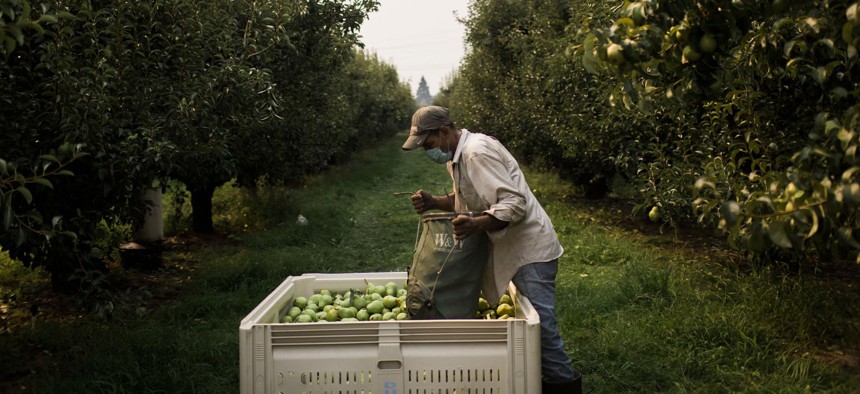New Index Ranks Best and Worst States for Workers

An orchard worker unloads a bag of pears in Hood River, Oregon on August 13, 2021. MICHAEL HANSON/AFP via Getty Images
Researchers looked at over two dozen types of policies in all 50 states as part of their analysis.
When it comes to proactively protecting and supporting workers, Oregon is the state with the best policies in place, while North Carolina ranks worst, according to a new report.
Oxfam America—a nonprofit focused on ending poverty—ranked the best and worst states to work based on three policy areas: wages, worker protections and rights to organize. The report looks at all 50 states, as well as Washington, D.C. and Puerto Rico.
The 10 best states for workers, according to the report, include:
- Oregon
- California
- Washington
- Washington, D.C.
- New York
- Massachusetts
- Connecticut
- New Jersey
- Colorado
- Illinois
This is Oregon’s second consecutive year at the top of the Oxfam ranking. The state has held its lead spot in part because of its strong unemployment benefits and comprehensive paid leave policy, which covers part-time employees and includes “safe leave” for survivors of sexual assault, harassment and domestic violence.
Meanwhile, Oregon, California and Washington are the only states with laws that protect outdoor workers from extreme heat. Oxfam America has been issuing its “Best States to Work Index” annually since 2018, but this year’s analysis is the first to include data about what states are doing to protect workers from extreme heat.
The 10 worst states for workers, according to Oxfam, (listed from worst to better) include:
- North Carolina
- Mississippi
- Georgia
- Alabama
- Texas
- South Carolina
- Kansas
- Oklahoma
- Utah
- Idaho
All of the bottom-ranking states have a minimum wage of the federally mandated $7.25 per hour and “right to work” laws that weaken labor unions. None of these states provide paid sick or family leave.
The analysis is intended to offer a blueprint for how states can better support their workers, as well as highlight policies that are working well, the report said.
“There is no state with a perfect score; even those states at the very top of our ranking have room for improvement,” it said.
To see each state’s “scorecard,” click here.
Other Findings
- In no state can a full-time worker support a family of four on minimum wage, the report said. Washington comes closest, where minimum wage covers 38% of a four-member family’s cost of living, the report said. Every state is worse in this metric compared to last year, largely due to inflation.
- Most states do not mandate any kind of paid leave or fair scheduling practices.
- There is a strong correlation between a state’s ranking and its residents’ well being, as measured by taking into account food insecurity, infant mortality and the percentage of the population living below the federal poverty level.
The report is based on policies that were in place as of July 1, and researchers tracked 26 policies for the analysis.
To read the full report, click here.
Molly Bolan is the assistant editor for Route Fifty.
NEXT STORY: Winners Announced for $1B in Regional Development Grants






